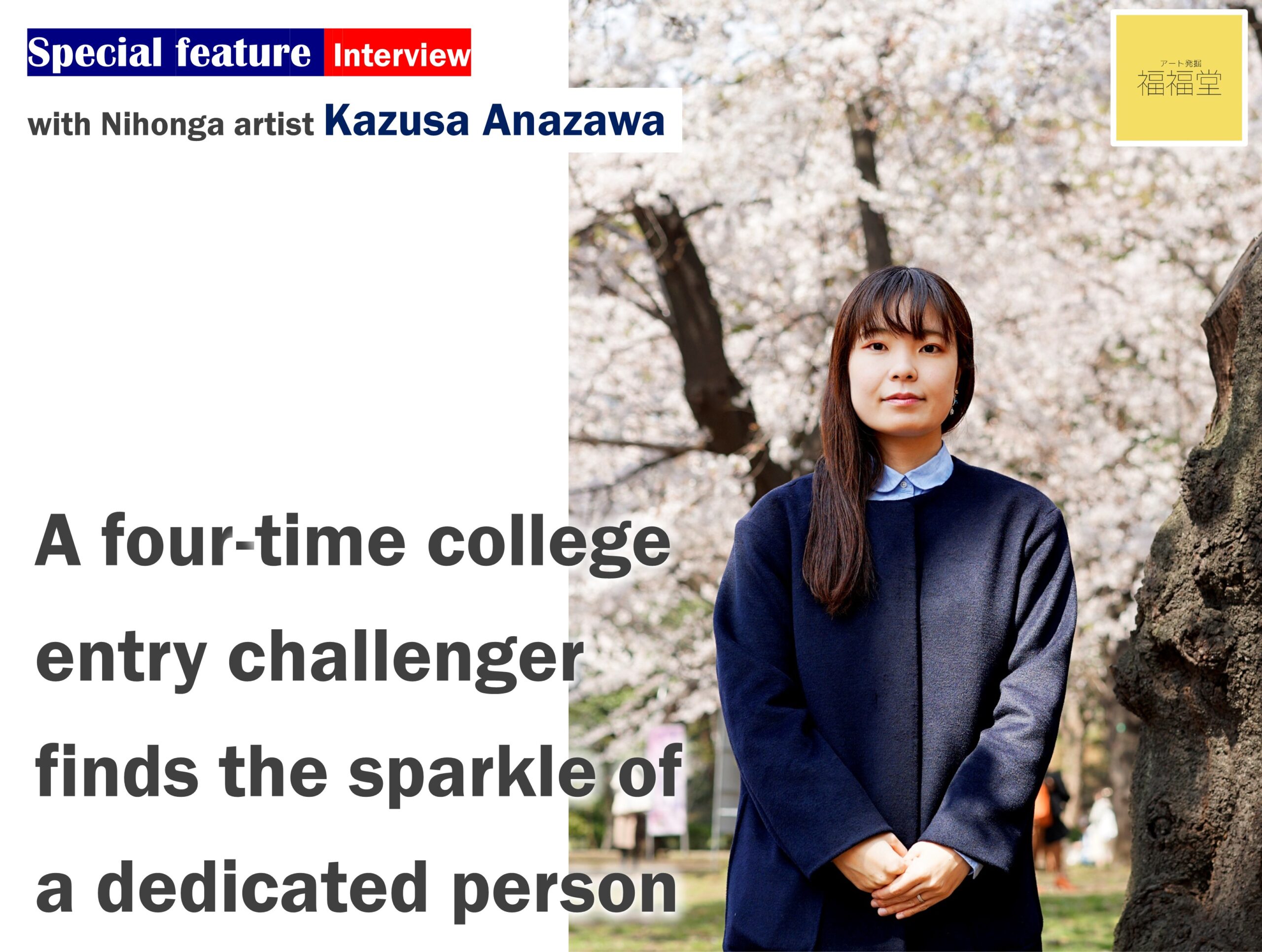
Interview with Nihonga artist, Kazusa Anazawa. Please enjoy reading this interview by the FFD editorial team!
Interview with Nihonga artist Kazusa Anazawa
Discovering the joy of drawings through Leo Lionni’s Little Blue and Little Yellow.
Thank you for your time today. Can you tell me about your first encounter with drawing?
I’ve been drawing pictures since my preschool days. Of course, back then I was drawing with crayons, not doing Nihonga paintings.
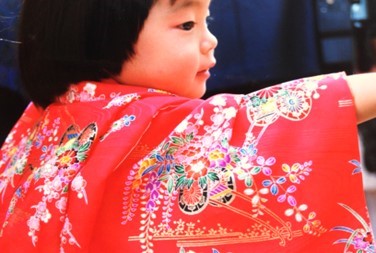
Why did you start drawing?
I’m not sure if it was something that made me start drawing, but one day, my mother bought me a picture book by Leo Lionni, titled Ao-kun to Kiiro-chan (Little Blue and Little Yellow), and this book made me recognize that drawings were fun.
In the book, when little blue and little yellow get together, they’re so happy they turn green. But when their parents tell them that “green is not our child”, they get sad and start to cry. The drawing on the page isn’t that of a person or an animal, it’s merely a circle. It was a strange experience, being able to feel the emotion even though there were no expressions drawn on the circle. This is what made me recognize that drawings were interesting.
Did you continue to draw in elementary and middle schools?
In middle school, the art club wasn’t that active, so I joined the manga research club instead. I liked to draw illustrations, and thought that might be a good fit. However, I didn’t like the popular manga at the time, and I began to think that it might not have been what I wanted to do. At the same time, the art classes were getting interesting for me ? maybe because the teachers liked and complimented my work. I also liked art, so I decided to go to a high school that had an art course.
The entrance exam included a practical assignment, which was to draw a self-portrait within four to six hours. My teacher was very kind to me and even took time from their summer break to coach and give me intensive lessons. I feel very fortunate to have had such a kind teacher.
What did the intensive sessions include?
I practiced drawing a self-portrait on a paper slightly larger (charcoal paper to B1 size) than the entrance exam assignment size. I made numerous drawings. As a middle school student, I didn’t have the option of attending an art prep school, so I relied on the intensive lessons from my school art teachers. I also made many drawings on my own after school. That was how I was able to pass the high school entrance exam.
Did your passion for art surpass the hardship of the intensive sessions?
Yes, I loved art. Perhaps it was because I wasn’t very good at studying, but I was hoping that I could pave the way for myself by passing the high school entrance exam in art.
You still make paintings of beautiful women; is this influenced by the self-portrait training?
The portraits I draw now use a model other than myself. I painted so many self-portraits in middle school, more than enough to last a lifetime. These days, I can ask models to pose for my drawings. When I draw other, beautiful people, I can draw freely, so it’s a lot more enjoyable for me.
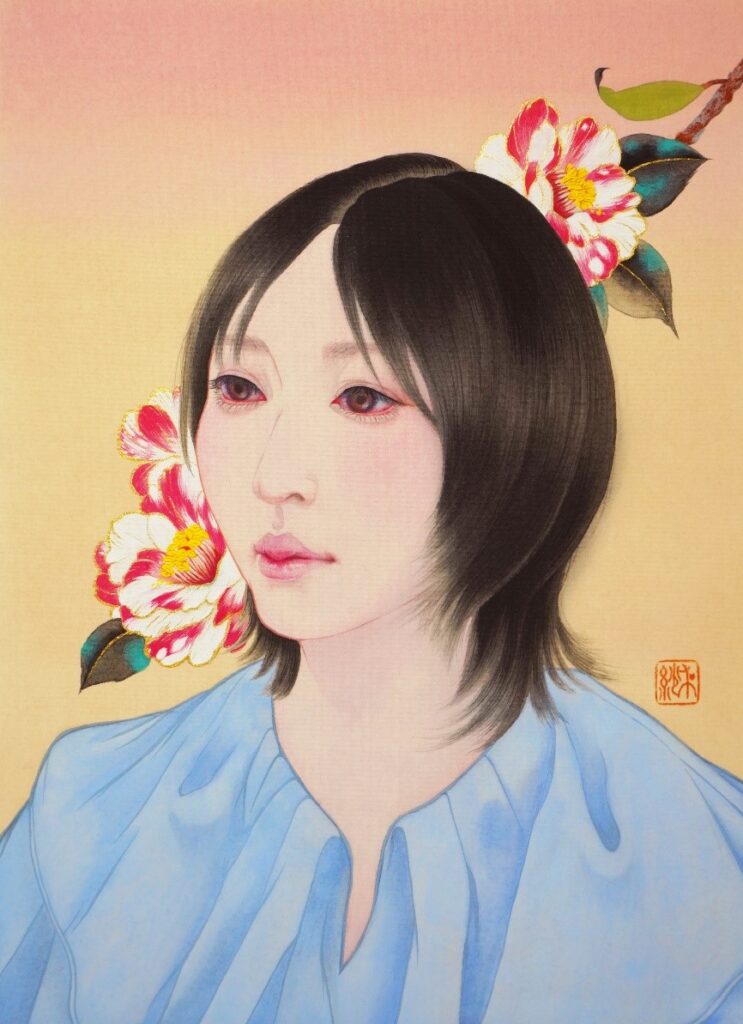
It just clicked, pursuing Nihonga in high school
When did you seriously consider becoming an artist?
I remember wanting to become an illustrator or a voice actor back in middle school. I can’t recall the reason for my interest in voice acting. I still have my middle school essay book where I wrote down my future dreams, but I’m too scared to read it.
In high school, I became interested in becoming a painter. I had no concrete image of what life was like as an artist, but I had the vague idea that my future would involve art and painting.

What did you study and what type of art did you create in your high school’s art course?
I attended the fine arts course at Katakura Metropolitan High School. We study fine arts and design in our sophomore year. The students choose amongst the two tracks in our junior year. In your senior year as a fine arts student, you decide on a major within the oil painting, Nihonga, or sculpture track. I chose the Nihonga track in fine arts.
So you chose Nihonga while in high school.
Yes. While I tried other techniques, the Nihonga felt the most natural to me. The decision was instinctual more than anything else. I think the two-dimensional aspect appealed to me more than sculptures. I was used to working with watercolor since elementary school, thus Nihonga felt like a natural progression.
However, I still had little knowledge of what kind of painting materials were used for Nihonga at that time and I learned the basics during my senior year in high school. Nihonga uses washi, sumi ink and mineral pigments, all of which are materials made from nature, and that aspect appealed to me as well. By that time, I had already started thinking in terms of looking for universities where I can study Nihonga.
5 failed attempts at Geidai entrance exams, and working part-time to pay for prep school
It’s important to experience various techniques so that you’re better equipped to choose your future path. Your high school was a good starting place to pursue your interest in Nihonga. Did you apply to Tokyo University of the Arts (Tokyo Geidai)?
Yes, I took the entrance exam five times, including straight out of high school.
Five! Did you go to a prep school to help prepare for the entrance exams?
I did. I took the exams five times, but didn’t pass in the end. During the last couple of years, I worked part-time until the summer to help pay for prep school classes. I didn’t want to cause too much financial strain at home. I think I started prep school from summer onwards.
What kind of part-time jobs did you do to pay for your classes?
I ended up doing a lot of jobs including during my years at the correspondence course.
I worked at a cafe, a beef bowl fast-food chain, a hotel catering service, a Japanese-Italian restaurant, and so on. The jobs that included meals were a huge help. Working the night shift at a plastic beverage bottle manufacturing facility was the most physically demanding one. I couldn’t stay awake and would almost fall asleep standing up. I learned from that job that night shifts weren’t for me.
The part-time catering jobs at the hotels were actually really fun because there were weddings and dinner shows. As a door opener, I had a full view of the stage to watch singers. The hotel staff would sometimes jokingly say “That’s a great seat ? 20,000 yen’s worth!”
A nice perk of the job.
A memorable experience was working as a cashier at a retail shop, and the manager asked me to sell the small chocolates shelved in front of the cash register. When I talked to the customers in line, I ended up selling a lot of chocolates and that gave me a small sense of accomplishment.
The store had a very cozy atmosphere and some customers came just to see the manager. I learned through this experience that some shops have a relationship with their customers who buy products you recommend.
When you look back, do you think that many of your part-time jobs were in the service industry?
I guess you’re right. I’m grateful for that experience, since it taught me how to interact with people. It helps me when I’m talking to people at my exhibitions. Having to work part-time was tough, but the experience has helped me.
Your part-time jobs might have seemed like a detour for your career path, but perhaps it was a helpful experience. Since this interview is being read by young aspiring artists, I’d like to ask what classes are like at an art prep school.
As part of the exam preparations, we were given assignments drawing plaster casts. We were assigned “detailed coloring” tasks where we had to observe the shapes of flowers or other organic forms, then draw them to scale until we were satisfied. Learning and practicing these art techniques was both fun and fulfilling to me.
The older students who were on their second, third or fourth tries with the entrance exams would mainly paint during the day, but I sometimes stayed after class into the evening and worked on my own next to the high schoolers, who came in the evening after their regular classes finished.
There were many teachers, classmates, and students older than me at the prep school, all of whom I highly respected. I learned a lot of the basic skills and techniques here. Painting requires skill, and I think all the time I spent here while I was trying to pass the entrance exams was integral to the person I am today.
As my painting skills gradually improved over time, I began to think that I would like to make my own paintings. During my years going to prep school, I frequently went to art museums and saw paintings at art galleries, before soon realizing that passing an entrance exam wasn’t the only option. I had no money, and after five tries at the exam, I decided that I’d done everything I could and that I had no regrets.
I decided to attend the correspondence course at Musashino Art University, where I could attend while working.



At the top of Mt. Fuji with my prep school teacher and classmates. “The sky and the sea of clouds I saw at the peak are the inspiration for my current works”
You made the best of those years working towards the entrance exams.
I did. However, spending four years attempting the exams with no success had a negative effect on me. My classmates had already graduated from college and were about to enter the workforce, while I was still working on the exams. For me, it was a dark time.
I can look back now, and talk about it cheerfully, but every year, I cried and became depressed. I wondered, “is it worth it for me to exist in society, to be alive?”. On the other hand, I believe the experience helped me to develop grit and learn the importance of commitment.
Communicating with others about my art saved me
You hold solo exhibitions at Ginza Mitsukoshi now. What would you want to tell yourself back in the days of prep school?
I want to reassure the prep-school-student-me “Don’t worry. You’ll manage to keep going somehow.” I developed an inferiority complex due to the continuous failure with the entrance exams, which persisted far after becoming an artist.
Gradually, perhaps around the time I was able to hold solo and group exhibitions, I found myself not worrying too much about it anymore. I was able to let go of the negative feelings I had back then, and I believe it was because I was able to connect with customers through my paintings, which extended to interacting with society. Painting helped me change my life direction for the better.
Now, let’s move on to your college days. What was your art style during college?
As a college student, I was into abstract painting. I started abstract painting because I admired the works and painters I met at an art gallery. It was completely different from my current style. During that time, I was invited to join that same painter’s group exhibition at a rented gallery space in Ginza. I also once entered my work as part of an art group in a public exhibition, and it was selected!
Did you hold your first solo exhibition while you were a college student?
It wasn’t until after I graduated from college that I held my first solo exhibition. I still wasn’t deemed good enough, and the galleries that offered commission-based exhibitions wouldn’t handle my works during college. That meant if I wanted to hold a solo exhibition, I had no choice but to save up the money and rent a gallery by myself. The only way to become a professional painter was to hold solo exhibitions so that the general public or collectors could buy my paintings, or to meet an art dealer and pave the way for myself.
My Nihonga paintings use gold and mineral pigments, so the materials are particularly expensive. As an art student, I had to earn enough money to rent a gallery space on top of the existing cost of art materials, tuition, and living expenses. It was tough making money. Sometimes, I was able to speak with the gallery owner and reserve the space while I was still eligible for the student discount. Then, I asked the gallery owner to postpone the payment of the venue fee until I had enough money working after graduating college. It was thanks to these kind people around me that I was finally able to hold my first solo exhibition.
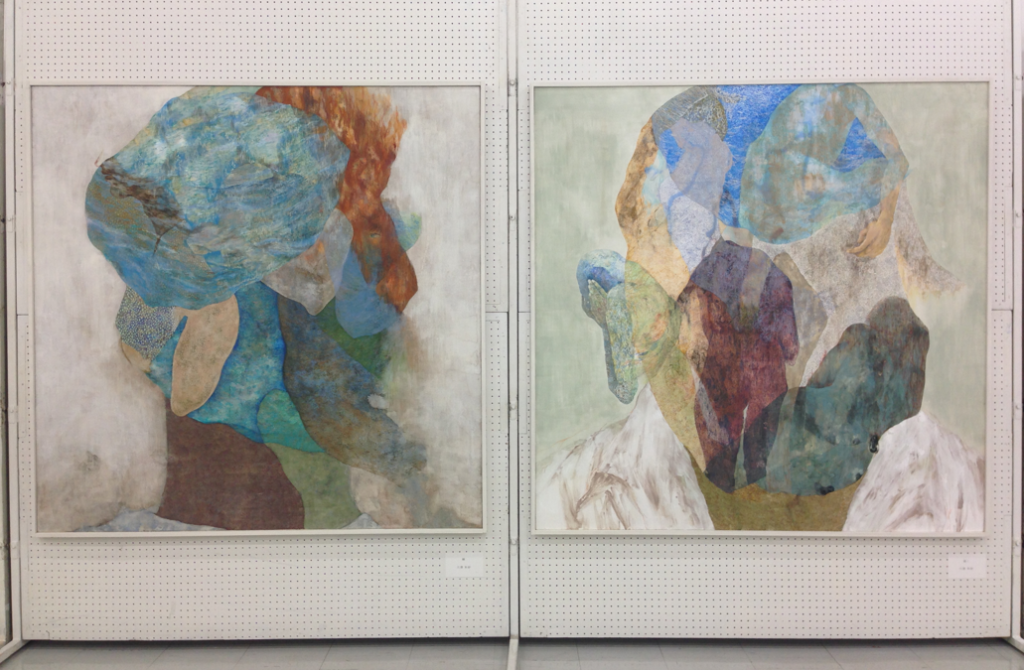
How was the reaction of the customers at your first solo exhibition?
I was pleased that my paintings sold and were recognized, even if only for a little. However, I was still struggling with my own style at the time. While I was a student, I was drawn in by the allure of Nihonga’s vivid colored mineral pigments, and would often apply more paint than necessary. It sometimes felt like I was being played with by the paint. After graduating, there was a period of trial and error where I experimented with cutting down on the amount of paint, or trying to work monochromatically.
Your senior capstone project received an award of excellence.
I was very happy with that. Still, I felt as if I was groping in the dark. After graduation, I continued to save up money and hold solo exhibitions. Even if one or two works sold, I continued to wonder if this was the right direction and whether this was what I wanted to paint in the future.
Was the road to becoming a professional painter difficult?
Yes, it was. It was right around that time that I saw an article by Fuyuhiko Yamamoto, an art sommelier, introducing Fukufukudo’s Art Management course on his facebook page. I was desperate and clutching at straws and joined the program.
I see.
I began participating in group exhibitions at department stores while learning from the producer. I continued to learn and acquire the necessary skills to become a painter as I reflected on my work, and through more trial and error, I began to see the results. After a while, I noticed a shift in my mindset, and could acknowledge that I was gradually getting closer to becoming a professional artist. After three or four years, I was able to hold a solo exhibition, having graduated from the group exhibition. At the solo exhibition, I saw that there were many customers who liked my work. I felt that I could confidently call myself a professional artist at last.
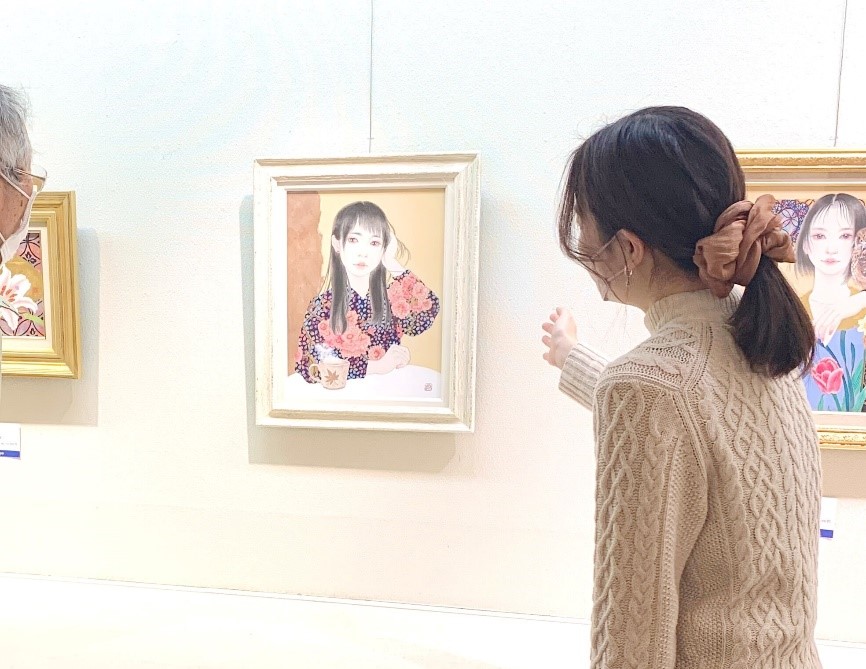
Painters find the joy of connecting with people and contributing to society through their art
You met some wonderful clients and started your career as a professional painter. I’m glad to hear that your efforts have begun to pay off.
Indeed, I am very grateful. One of my exhibition pamphlets included a painting of a woman. This exhibition was held far away, but the pamphlet somehow made its way to a doctor who got in touch with me a year later and asked me whether I would be willing to paint a picture to be displayed at his hospital. It was the first time I’d had such an inquiry.
Through letters and phone calls, we discussed the early stage drawings, the main painting, and were finally able to produce four final pieces. I was also able to meet the client in person later and see my paintings on display. It was an amazing experience that taught me the joy of connecting with people and contributing to society through my paintings despite any physical distance. That same customer continues to support me to this day, and I treasure this whole experience.
What a delightful experience!

Another customer of mine asked me to “create a painting in the image of a special nurse and a star”. They said that they had recently been hospitalized while sick, and the nurse who had cared for them had been named after a star. They could only make out the nurse’s eyes since she always wore a mask at the hospital, and thus asked me to use my imagination to portray the nurse in my own way. I created the painting almost as if I was praying for the customer and thinking of her. I’ll never forget the joy on her face as she thanked me with tears in her eyes when I brought the completed painting to her.
I try to be at my solo exhibitions, no matter where they may be held. This is because it’s very valuable for me to meet and talk with my customers in person. I have previous memories of all my customers and I can’t talk about them enough. Just as my customers enjoy having my paintings on their walls, I receive joy and learn from my customers. I hope to continue making sparkling paintings with gratitude towards these encounters.
There are sparkling moments in the minutiae of daily life
Your recent paintings feature flowers, particularly peonies and cherry blossoms. Is there a special reason?
I’ve always loved to paint flowers. Peonies are gorgeous and known as the “king of a hundred flowers”. I enjoy portraying the cadence of their flower petals, and I think peonies are some of the best subjects to show the artist’s perspective. I visit the peony gardens in Nishiarai Daishi and Ueno Toshogu Shrine every year for research. In 2022, I even managed to visit Daikonjima in Shimane, which is renowned for its peony gardens.

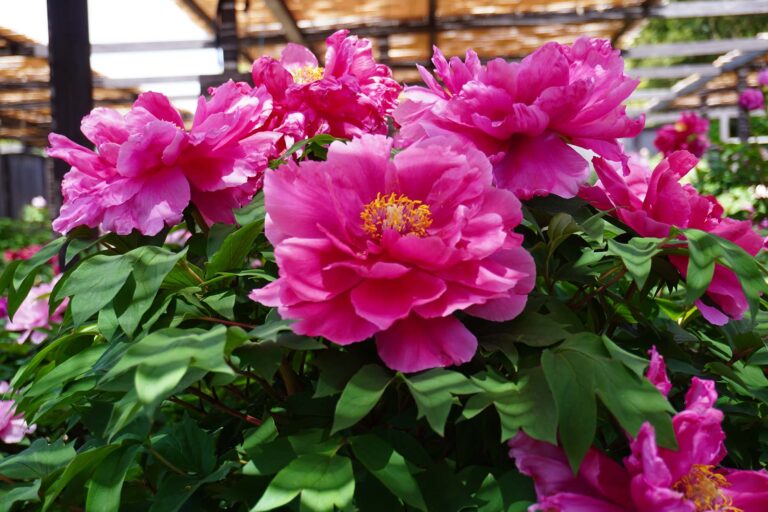
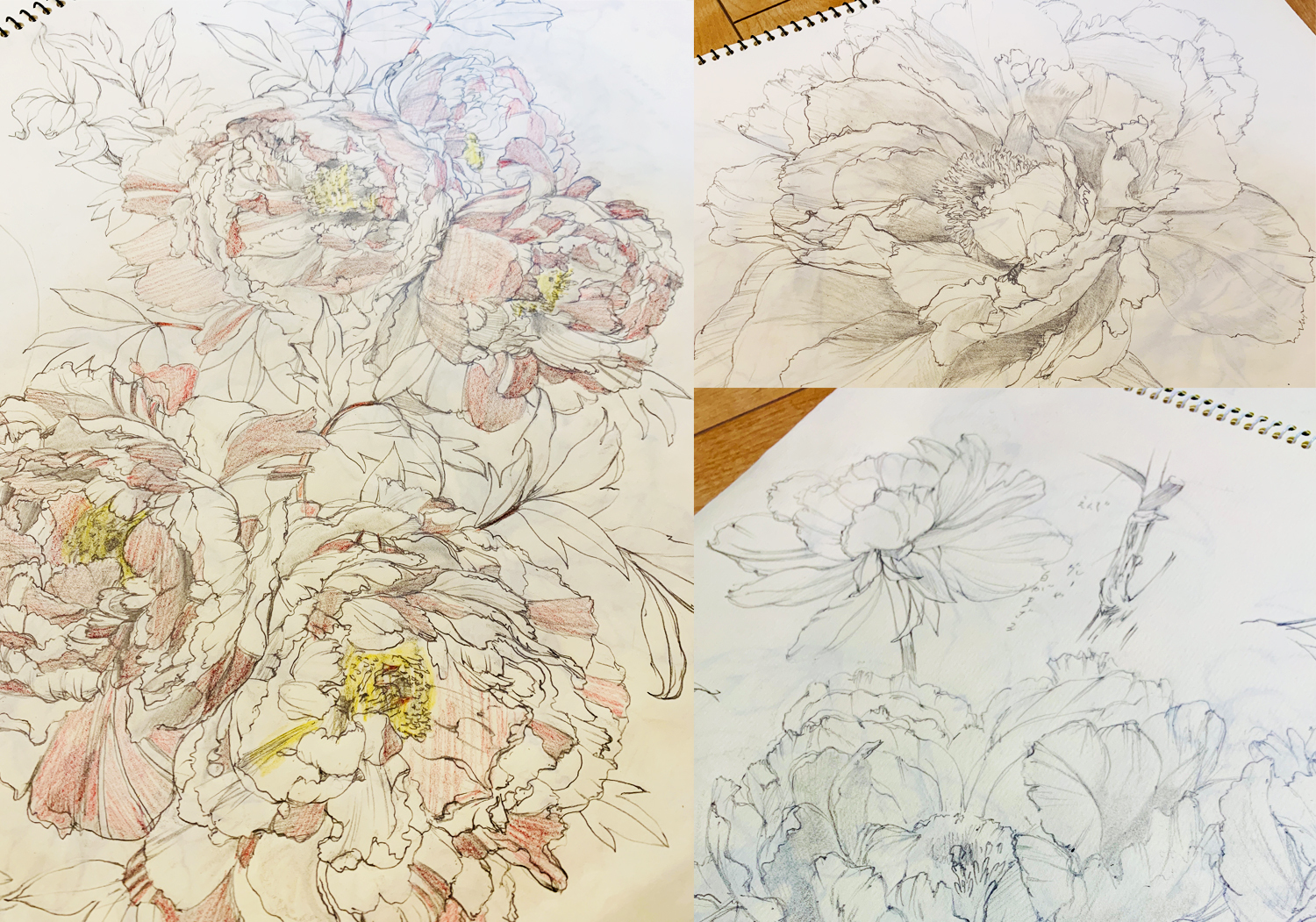
— That’s a pretty long way to go. How was the Peony Garden in Shimane?
I went on a trip for three days and two nights. The first day had great weather, but there was heavy rain on the second day. I was disappointed, as this was the last day I could cover the event, but I discovered the nobility of the flower through seeing the peonies in full bloom in spite of the heavy rain, aptly named the “king of a hundred flowers”.

The downpour turned out to be a gift. Do you paint cherry blossoms as well as peonies?
I do. Cherry blossoms have long been Japan’s favorite flower. It’s a motif which many people share their memories with throughout time. Here, most everyone has memories of walking under cherry trees with their family or loved ones. Cherry blossoms have a short life span and are beautiful when the petals fall, and share a common idea with the theme of my art’s “sparkle”.
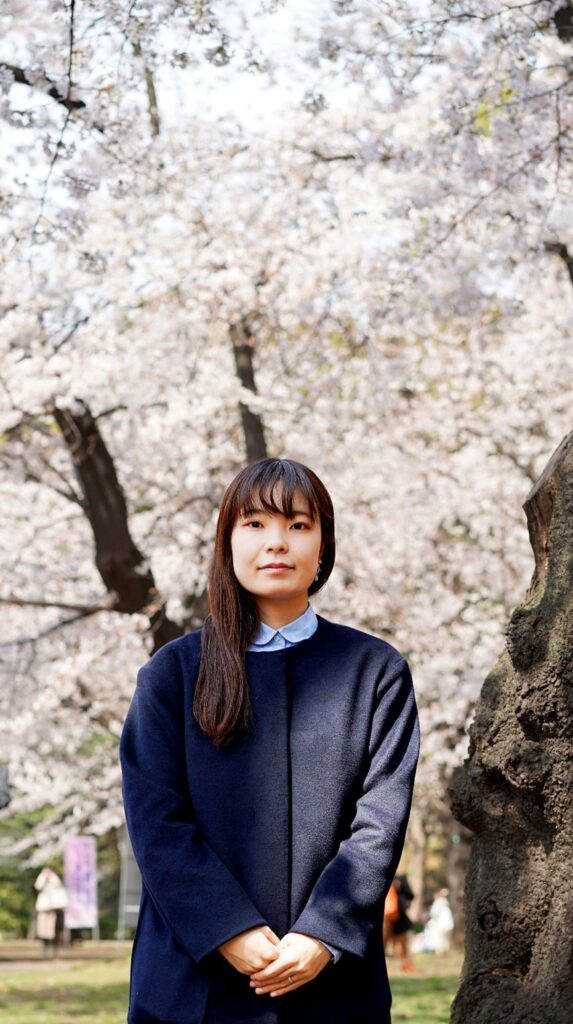


Your paintings portray a sense of fragility and charm. Perhaps it’s because you capture beauty through its short life and form as it falls.
When I paint cherry blossoms, I usually combine it with the clear blue of the sky, which I use in a dual sense with how the character for ‘blue’ is part of the word ‘youth’ in Japanese. The word has a sense of transience. I turned 36 in 2024, which means I’m a ‘toshi-onna’ (those born in the same year as the current year’s zodiac). I went through four years of entrance exam prep, working part-time to pay for tuition and art materials. I’ve spent my life as far as it can get from any ‘sparkling’ period. Yet, all the time there are these moments of sparkle in the minutiae of daily life and I can feel the beauty of each and every day. I see this as youth and life, and find hope in it. The cherry blossoms and the blue sky is a motif I’ll continue to work with in the future.
Thank you very much for your time today. I look forward to seeing your solo exhibitions!
(Interviewed by FFD editorial team)
Description of Kazusa Anazawa’s work Shunsho no Matataki (The Blink of an Evening in Spring)

I had several cherry blossom viewings with my grandparents in my hometown. We just talked about trivial things, but I remember that everyone was very happy. I also remember walking with my family and loved ones under the cherry blossoms in Ueno Park. Cherry blossoms only last for two weeks, but seeing them in full bloom brings back many wonderful memories. Seeing the cherry blossom paintings by Kazusa Anazawa brings back their sparkle!
(description by FFD editorial team)
Artist Kazusa Anazawa bio, awards, and exhibitions
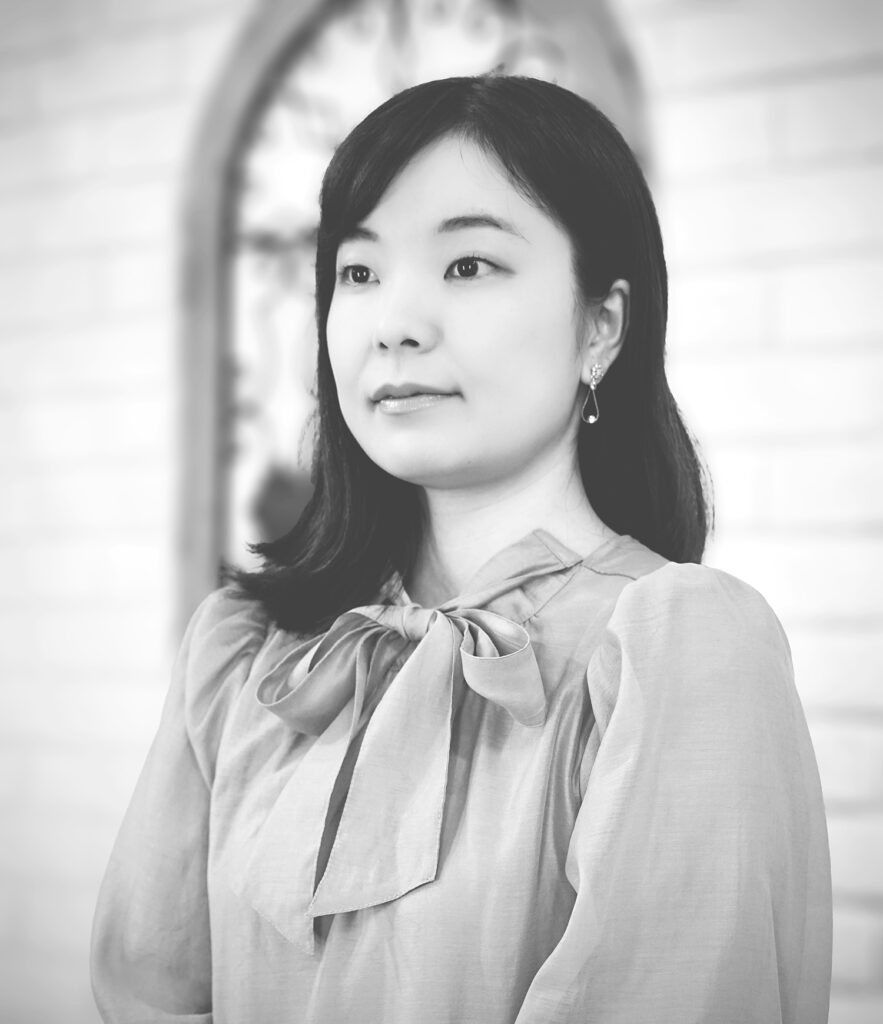
Kazusa Anazawa
1988 Born in Funabashi, Chiba
2014 Graduated from Musashino Art University, Faculty of Art and Design, Correspondence Course of Nihonga (Senior capstone project, Excellence Award)
2016
Group Exhibition Isetan Urawa Store, Saitama
Group Exhibition Hanshin Umeda Main Building, Osaka
Group Exhibition Matsuya Ginza, Tokyo
2017
Group Exhibition Tama Plaza Tokyu, Kanagawa
Group Exhibition Fukuya Hatchobori Main Building, Hiroshima
Group Exhibition Isetan Urawa Store, Saitama
Group Exhibition Hanshin Umeda Main Building, Osaka
2018
Group Exhibition Fukuya Hatchobori Main Building, Hiroshima
Group Exhibition Isetan Urawa Store, Saitama
Group Exhibition Hanshin Umeda Main Building, Osaka
2019
Trio Exhibition Tobu Department Store Funabashi, Chiba
Group Exhibition Fukuya Hatchobori Main Building, Hiroshima
2020
Kazusa Anazawa Nihonga Exhibition “Toko Hatsu Hana no Sora”, Chiba-gin Himawari Gallery, Tokyo
Kazusa Anazawa Nihonga Exhibition “Toko Hatsu Hana no Kaze”, Hanshin Umeda Main Building, Osaka
2021
Kazusa Anazawa Nihonga Exhibition “Hanaemi no Toki”, Fukuya Hatchobori Main Building, Hiroshima
Kazusa Anazawa Nihonga Exhibition “Hanaemi no Sora”, Tobu Department Store Funabashi, Chiba
2022
Kazusa Anazawa Nihonga Exhibition “Hana no Kowairo”, Isetan Urawa Store, Saitama
Trio Exhibition, Shizuoka Isetan, Shizuoka
Kazusa Anazawa Nihonga Exhibition “Ten Takaku, Hana”, Hanshin Umeda Main Building, Osaka
2023
Kazusa Anazawa Nihonga Exhibition “Saekaeru Hibi”, Fukuya Hatchobori Main Building, Hiroshima
Kazusa Anazawa Nihonga Exhibition “Zuifuu Kaoru”, Isetan Urawa Store, Saitama
Kazusa Anazawa Nihonga Exhibition “Sora no Hana no Yume”, Tobu Department Store Funabashi, Chiba
YouTube: https://www.youtube.com/channel/UC4WFF9wMCz7GWmlFL2kmb-w
Kazusa Anazawa’s YouTube channel mainly introduces her works and activities as an artist through videos.
Website: https://anazawakazusa.wordpress.com
Details of Kazusa Anazawa’s exhibition
Coming soon…
